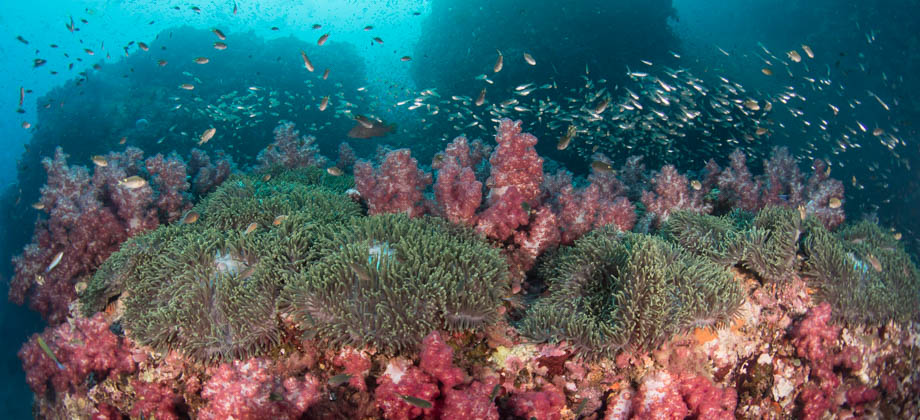Similan Islands
Colours & Shades
Another common example of mimicry is that of the schooling bannerfish
(Heniochus diphreutes) and its almost identical cousin, the longfin bannerfish
(Heniochus acuminatus). Both these fish mimic the moorish idol
(Zanclus cornutus). The moorish idol is the only extant species of its genus, and its name was derived from the Moors, who apparently believed it to be a harbinger of joy and happiness. The moorish idol is a diurnal fish and its vibrant colours fade a little at night, which makes its eyes a bit more visible. It also tends to stay close to the reef at night.
 Moorish idols (Zanclus cornutus) and schooling bannerfish (Heniochus diphreutes).This shot was taken at dusk before the colours of the former began to change
Moorish idols (Zanclus cornutus) and schooling bannerfish (Heniochus diphreutes).This shot was taken at dusk before the colours of the former began to change
Marine life that stay really close to the reef are referred to as benthic. There are plenty of colourful benthic fish that can be seen once divers look below and past all the other colours that swirl above the reef. Bluespotted stingrays
(Neotrygon kuhlii) can sometimes be seen in the sandy areas, and moray eels of all types take position in nooks and crannies and patiently wait for tasty morsels to swim by. There are plenty of crustaceans hidden away too--painted spiny lobsters
(Panulirus versicolor) and vibrant peacock mantis shrimps
(Odontodactylus scyllaris) are normally tucked away under shelves, whilst porcelain anemone crabs
(Neopetrolisthes maculatus) seek protection within the soft, venomous tentacles of
sea anemones.
 Tassled scorpionfish (Scorpaenopsis oxycephala); A blotched porcupinefish (Diodon liturosus) hiding behind honeycomb oysters (Hyotissa hyotis)
Tassled scorpionfish (Scorpaenopsis oxycephala); A blotched porcupinefish (Diodon liturosus) hiding behind honeycomb oysters (Hyotissa hyotis)
The true benthic masters of colour, however, are stonefish and scorpionfish. These remarkable, and highly venomous, fish have the ability to change their colours in order to blend into their surroundings. They also have filamentous tentacles or tassels that resemble algae, with some stonefish having actual algae and hydroid growths on their body. The growths and tassels not only make them look more like coral, but they also attract hungry herbivorous fish. Once the prey is close enough, the jaws of the scorpionfish open extremely quickly and create a vacuum that sucks the prey into the cavernous opening that is their mouth. It is over as quickly as it began, its amazing camouflage making it vanish back into the coral.
 A close-up of a tassled scorpionfish (Scorpaenopsis oxycephala) hidden on the reef
A close-up of a tassled scorpionfish (Scorpaenopsis oxycephala) hidden on the reef
Speaking of
camouflage, I would be remiss if the wonderful cuttlefish were not mentioned here!
Cuttlefish seems to have perfected the art [of camouflage]. These voracious predators are able to observe their surroundings and not only change their colours accordingly, but are also able to manipulate sections of their skin called papillae in order to match the physical texture of the surface that they are imitating. These changes of colour are not only used for the purpose of camouflage when hiding or sneaking up on prey, but also to mesmerise their prey when the colours are flashed repeatedly. Male cuttlefish have also been observed imitating females to increase their chances of mating!
 A broadclub cuttlefish (Sepia latimanus)
A broadclub cuttlefish (Sepia latimanus)














